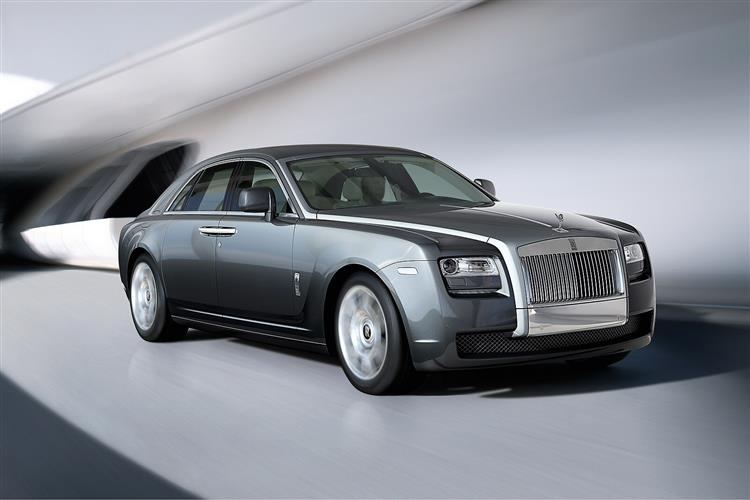GHOST IN THE MACHINE (some text hidden) --NONE--
By Jonathan Crouch
Introductionword count: 68
For the ultimate in automotive technology concealed behind a veil of leather and wood with a cloud-like driving experience courtesy of a V12 twin-turbo engine, look no further than the Rolls-Royce Ghost, introduced in 2010. Few opulent saloons can come close to matching it for comfort - and that's reflected in the price - but luxury limos from the 21st century's second decade just don't get much better.
Modelsword count: 6
4dr Luxury Saloon (6.6-litre V12 petrol)
Historyword count: 204
Rolls Royces are traditionally driven by people other than their owners. If you can afford one, you can afford to sit in the back. But what kind of car might this famous brand make if it were to design a means of conveyance aimed at people who would slip behind the wheel themselves? One as comfortable with curves as it was in the showroom? In 2010, we got our answer with this car, the Ghost. Rolls Royce had been here before. Back in 1929 when, like today, their range was headed by an imposing Phantom model, the company identified the need for a slightly smaller, more driver-orientated design. But the 20/50 model they produced was feebly-powered and ultimately unsatisfying. Perhaps in fear of repeating this mistake, the modern era Ghost employed hi-tech handling and a 6.6-litre twin-turbocharged V12 that was actually more powerful than its larger and pricier Phantom stablemate. Plus it's still an astonishing thing to ride in. Some things never change. Rolls Royce substantially updated this design to create what was known as the 'Ghost II' in 2014. This gained styling revisions inside and out, plus a 'Dynamic Driving package' and 'Satellite Aided Transmission'. A second generation Ghost model arrived in 2020.
What You Getword count: 468
At a quick glance, you might mistake this Ghost for its larger Phantom stablemate, the elevated prow, the long bonnet, the short front overhang, sharply-raked C-pillar and elegant tail all familiar Rolls Royce styling cues. Yet look a little closer at Range Rover designer Ian Cameron's majestic 'yacht line' styling and a more dynamic feel beckons from the powerful profile. The post-2014-era 'Series II' model is identifiable by its tapered 'wake channel' on the bonnet, chrome inserts in the front air intakes and subtly revised bumpers, plus the side character 'waft line' was slanted further forward. On all Ghosts though, it's what's underneath the sculpted panels that's of rather more interest. Instead of the Phantom's aluminium spaceframe, there's a steel monocoque, a more efficient solution that requires no separation of chassis and body. As a result, though this car is 0.4-metres shorter than a Phantom, it's pretty much the same size inside. Which is something you best appreciate from a seat in the rear. Entry is via coach doors, unusual in the way they aid access by hinging at the back rather than the front and can be closed at the press of a button. Once inside, original Ghost customers had the choice of individual chairs separated by a centre console or a rear 'lounge seat' which features curved outer edges, making it easy to turn and face a fellow passenger. Either way, the base is elevated for a peerless view past the electronically retracting Spirit of Ecstasy to the road ahead. It's also neatly situated behind the rear C-pillar for safety as well as privacy from aspiring paparazzi. This sumptuous interior is crafted from the finest leather and timbers available, one reason why every Ghost took at least 20 days to build before it spent seven days being painted and polished to perfection. The cabin features elegant frosted lamps and chrome door handles, traditional 'violin key' switches and eyeball air vents, frosted white dials and refined instrumentation. At least eight hand-stitched hides were required for each car and all seats and interior panels are hand-stitched. Equally painstaking is the use of hand-sanded wood veneer with wood from only a single tree used in any given car so that each area ages and colours at the same pace. At the wheel, you don't sit quite as high as you would in a Phantom but it's still a commanding perch. The arc of the bonnet means that it's difficult to see the front corners of the car and at 5.4-metres long and nearly 2-metres wide, this isn't the easiest thing to manoeuvre into tight spaces but you do quickly adjust, thanks to the large mirrors and the clever proximity sensors on the corners of the car. Boot space, at 490-litres, is usefully larger than you'd get in a Phantom.
To see the full road test text contact us on 0330 0020 227
Pictures (high res disabled)

.jpg)
|
.jpg)
|
.jpg)
| |||
.jpg)
|
.jpg)
|
.jpg)
| |||
.jpg)
|

|
Scoring (subset of scores)
Category: Luxury Saloons and Estates
| Performance | |
| Handling | |
| Comfort | |
| Space | |
| Styling, Build, Value, Equipment, Depreciation, Handling, Insurance and Total scores are available with our full data feed. | |



